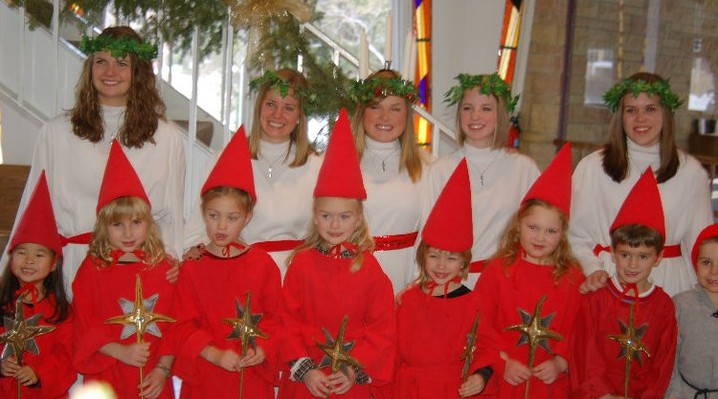For the past 71 years, the Festival of St. Lucia has been celebrated at Gustavus with a chapel service featuring a court of five sophomore women. These women were chosen for their leadership, service to the college and others, charity, kindness and thoughtfulness.
The Guild of St.Lucia, which consists of 15 women from the senior class of high academic achievement and community service, takes responsibility for the preparation of the Festival of St. Lucia each year. There has been much controversy in the past, however, on how St.Lucia has been chosen.
“There are many criteria that we ask for people to consider,” Assistant to the President for Special Projects in the President’s Office and Co-Adviser of the Guild of St. Lucia Barb Larson Taylor has said.
“Over time, there has been an unintentional bias of perception of who should really be on the court. Because of this, people automatically don’t vote because it doesn’t apply to them or their friends. They don’t consider certain groups of sophomore women who, in their perception, don’t fit how the court looks like.”
In other words, St. Lucia has come to inadvertently represent a single population of Gustavus students.
“There have been wonderful women but it has been a very homogenous group of women and it isn’t representative,” Taylor said. “We’ve discussed it a lot this year and thought about how to make the group more inclusive and representative of our diverse community.”
Many students on campus have the notion that only certain women of Swedish heritage are eligible to be selected as St. Lucia. This outlook, however, is misconstrued.
“We’re trying to get people to realize it’s not just a choir and Swedish thing and thinking beyond just a specific thing,” Senior Public Accounting Major and Member of the Guild of St. Lucia Anna Swenson said. “We’ve utilized strong women throughout history [in our posters and videos] that represent different women throughout pockets of society. We’ve been discussing with organizations and telling them that it’s really about the characteristics and traits of St. Lucia that matter. The goal is to make people understand what they’re voting for and why.”
These characteristics, as the Guild describes them, consist of: courageous leadership, service to others, strength of character and compassion.
Even with these general criteria, many students still fall under the impression that St. Lucia must belong in a stricter set of unnamed guidelines.
“All of the characteristics to be eligible can apply to 90 percent of girls who are deserving,” Senior Sociology and Anthropology and Political Science Major Irma Marquez said. “I want to see change in the court, because every year I see sophomore women who work very hard who aren’t recognized within the community and this may be just because their organizations may not be as high as, for example, the Campus Activities Board. I still get asked what PASO, ACC and all these diverse organizations mean and it’s because most of the events that are put on by those organizations only have the same people attending and they think it’s not open to everyone.”
Women representing different ethnicities nominated in the past several years have been few and far between. On account of this, students across campus have expressed unease in reference to the goal of St.Lucia.
“Irma and I are both very concerned about racial representation,” Senior Gender, Women and Sexuality Studies, English and Religion Major and member of the Guild of St. Lucia Elizabeth Coco said. “Some people think you have to be in choir, blonde, involved in certain activities, or be of Swedish heritage—all of these are misconceptions.”
In response to this mistaken belief, the Guild has worked to publicize the Festival of St. Lucia as open to all ethnicities. This includes the representation of well-known, diverse women who have made an impact on society, such as Rosa Parks, Anne Frank, Ellen Degeneres, Kao Kalia Yang and Rigoberta Menchu.
“We’re trying to make this as diverse as possible,” Coco said. “We have people on campus who aren’t visible but are here. We have African Americans, Latinos, and all these groups that haven’t been represented on the court. It’s not that they aren’t deserving but are not visible.”
St. Lucia and the Festival of Lights’s origin lies in the fourth century martyrdom of an Italian saint by the name of Lucia (meaning “light”). At the age of 20 years old, Lucia was killed because she refused to renounce the Christian faith. According to Swedish legend, after Lucia’s death, a ship carrying a maiden “clothed in white and crowned with light” appeared on the shore in the Swedish province of Varmland during a great famine.
The maiden, widely believed to be Lucia, distributed food and clothing to the needy, thus endearing herself to the Swedish people. She symbolizes the coming end of the long winter nights and the return of the light to the world.
“The St.Lucia festival is a prime example of a way that Gustavus can honor our Swedish heritage and the fact that it was founded by Swedish immigrants in a way of respect,” Taylor said. “But it’s a way of bringing it into a current context. It’s a loved Swedish tradition and we are bringing it into a context of what it means for Gustavus. I’m proud that the Guild is wrestling with a fairly tough issue. This year it has been difficult to rethink a process that has had some biases and how to create a result that is more reflective of what the intention is. I think it’s taken some strong leadership to say we are going to take this on. This is a way for us to think of things we’re doing on campus that we don’t realize we’re doing unintentionally.”
Nominations for sophomore women ended Nov. 18. Campus-wide voting will begin electronically Dec. 5, 2011 and continue through the next day.
